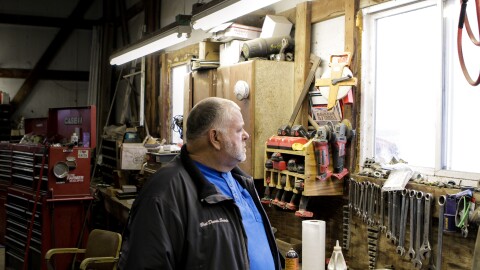The prices of the things we buy, from floor lamps to canoes and bicycles, are slated to go up, literally overnight, as the Trump administration makes good on a promise to raise tariffs on .
With trade talks between the U.S. and China , consumers and the businesses that serve them say they're bracing for bigger ripple effects.
Retailers, manufacturers, small farmers and multinational conglomerates are united in their concern about the potentially damaging impacts of additional tariffs to their businesses and their consumers.
The way that reverberates through Jim Kittle's family furniture business is indicative of how that might pass down through to consumers.
Kittle's Furniture started in 1932, expanded throughout Indiana and has remained in the family for three generations.
About 30% of all the household furnishings in their stores are made in China, then shipped by boat to the United States. As of Friday, new tariffs increased from 10% to 25%, raising the underlying cost of those items. (Tariffs of 10% on $200 billion of Chinese imports took effect last September. And back in April of last year, the Trump administration levied tariffs of 25% on $50 billion worth of Chinese goods.)
Determining new sticker prices will be a challenge for Kittle, who already has goods on order. If those goods shipped after midnight Friday, they were subject to the new tariffs.
"Is that going to affect the first container that arrives in Los Angeles?" he asks. "And if it is, we're going to have to reprice those goods on that container."
Kittle has been through this before. Last fall, a 10% tariff took effect. Back then, Kittle and his Chinese suppliers agreed to absorb most of that. The cost to consumers only increased 3%.
This time around, his suppliers can't afford to do that. And neither can Kittle nor other retailers — their profit margins are already so low.
Moreover, even the furniture that isn't made in China still often include parts manufactured in China, so those, too, will increase in price.
China took measures to counteract the effect of those price increases. In addition to imposing its own tariffs on U.S. imports to China, the country devalued its own currency. That had the effect of making Chinese products cheaper, relative to the U.S.
"Of course that's going to nullify some of the intended effect Trump is aiming for, which is to shift American producers and consumers away from Chinese goods," says Menzie Chinn, an economics professor at the University of Wisconsin, Madison.
Still, the previous rounds of tariffs are already making life more expensive. They've increased consumer costs by $1.4 billion a month, . To date, tariffs have largely affected raw materials like chemicals and wooden beams used to make other products, so the cost increases appear incremental to the consumer. But additional new tariffs would boost prices on a broader number of finished goods — things consumers actually buy, like bicycles.
This latest round of tariffs will add another $500 a year in costs for the average American household, says Katheryn Russ, an economics professor at the University of California at Davis. And that could grow. President Trump has pledged to broaden tariffs even further to all Chinese imports — including big-ticket items. "Once the tariffs go onto cellphones, I mean then you're going to see people scream," she says.
The sticker price issue is only one of Jim Kittle's concerns. Indiana's main industries include farming and car manufacturers, which are dealing with retaliatory tariffs China imposed on American goods. That means Kittle's customers are already squeezed. "If they don't have any money even to buy a tractor, they're not going to buy furniture," he says.
That precisely what's happening not far from one of Kittle's stores in Lafayette, Ind., to Brent Bible, a farmer.
Since China imposed tariffs last fall, Bible has nowhere to sell his soybean and corn crops. And that situation just got worse, because the futures trading market started planning for higher tariffs earlier this week, Bible said. "Just in the last three days of trading, we've seen the price reduction that equates to about a $50,000 loss for us," he added.
Bible isn't just running a business, he's also a consumer, and increased tariffs on steel and aluminum have raised prices on tractors and farm equipment he needs. As both a supplier and a consumer, he says tariffs are hitting him on both ends. "We are buying those products at an increased price, and we're paying that tariff."
Copyright 2021 NPR. To see more, visit https://www.npr.org. 9(MDA5NTM4MTIyMDE0MTg3NDc2MTVlZjdmNQ001))







